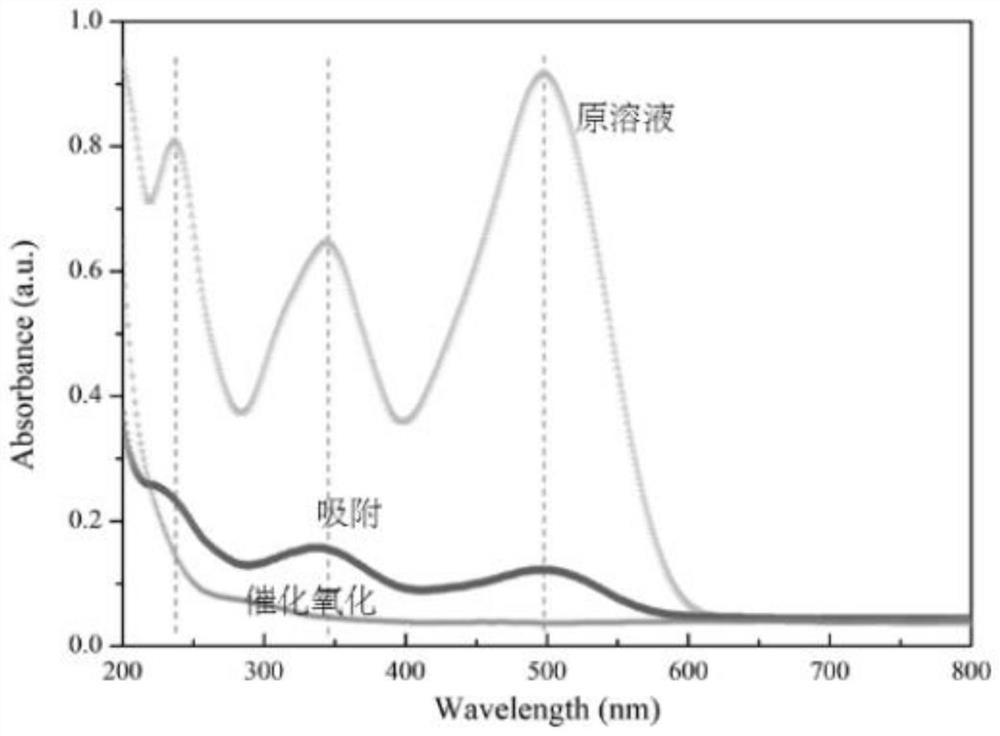A method for rapid adsorption and catalytic oxidation of Congo red to treat organic wastewater
An organic wastewater, adsorption and catalysis technology, applied in the directions of oxidized water/sewage treatment, adsorbed water/sewage treatment, chemical instruments and methods, etc., can solve the problems of high energy consumption, limited effect, high cost, and achieve simple phase composition, Time saving and low cost effect
- Summary
- Abstract
- Description
- Claims
- Application Information
AI Technical Summary
Problems solved by technology
Method used
Image
Examples
specific Embodiment approach 1
[0035] Specific embodiment one: a kind of rapid adsorption catalytic oxidation of Congo red of the present embodiment is carried out according to the following steps:
[0036] 1. Preparation of zero-valent iron biochar: crush rice straw and pass it through a 100-mesh sieve, then wash it twice with ultrapure water, then dry it in an oven at 60°C to constant weight, then take 5g of crushed rice straw and add it to 100mL In a mixed aqueous solution of polyethylene glycol 400 and ferric chloride hexahydrate, react in an oil bath at 100°C for 30 minutes under magnetic stirring. Raise the temperature to 700°C at a heating rate of / min, and carbonize at this temperature for 2 hours, and cool naturally to room temperature to obtain zero-valent iron biochar; the mixed aqueous solution of polyethylene glycol 400 and ferric chloride hexahydrate in the polyethylene The volume ratio of glycol 400 to water is 1:1, and the mass concentration of ferric chloride hexahydrate in the mixed aqueou...
specific Embodiment approach 2
[0038] Specific embodiment two: a kind of rapid adsorption catalytic oxidation of Congo red of the present embodiment is carried out according to the following steps:
[0039] 1. Preparation of zero-valent iron biochar: crush rice straw and pass it through a 100-mesh sieve, then wash it twice with ultrapure water, then dry it in an oven at 60°C to constant weight, then take 5g of crushed rice straw and add it to 100mL In a mixed aqueous solution of polyethylene glycol 400 and ferric chloride hexahydrate, react in an oil bath at 100°C for 30 minutes under magnetic stirring. Raise the temperature to 700°C at a heating rate of / min, and carbonize at this temperature for 2 hours, and cool naturally to room temperature to obtain zero-valent iron biochar; the mixed aqueous solution of polyethylene glycol 400 and ferric chloride hexahydrate in the polyethylene The volume ratio of glycol 400 to water is 1:1, and the mass concentration of ferric chloride hexahydrate in the mixed aqueou...
PUM
| Property | Measurement | Unit |
|---|---|---|
| concentration | aaaaa | aaaaa |
Abstract
Description
Claims
Application Information
 Login to View More
Login to View More - R&D
- Intellectual Property
- Life Sciences
- Materials
- Tech Scout
- Unparalleled Data Quality
- Higher Quality Content
- 60% Fewer Hallucinations
Browse by: Latest US Patents, China's latest patents, Technical Efficacy Thesaurus, Application Domain, Technology Topic, Popular Technical Reports.
© 2025 PatSnap. All rights reserved.Legal|Privacy policy|Modern Slavery Act Transparency Statement|Sitemap|About US| Contact US: help@patsnap.com



